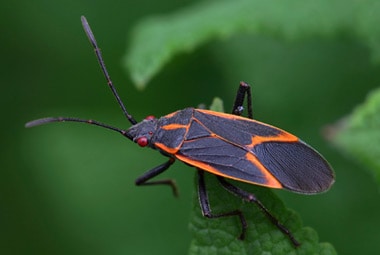
Boxelder bugs are a species of insect that are found outdoors most of the year. They usually only become problematic in the fall when they move inside of homes and other buildings to find a safe spot to overwinter. Boxelder bugs are commonly found throughout the eastern United States, eastern Canada and in the west to eastern Nevada.
| Pest Identification | |
|---|---|
| Recognition | Adult boxelder bugs are black in color and have distinctive red colored outlines along their thorax, wings and sides. They have piercing-sucking mouthparts. They have wings and can fly. Their wings are flat and lay across their backs. Adults can grow up to ½ of an inch in length. Nymphs are solid red in color and look very similar to the adults except that they are smaller in size and lack wings. |
| Biology | The life cycle of the boxelder bug is fairly simple and straightforward. In the spring the female lays her oval, reddish-brown eggs inside of trees or on their leaves. After a few days immature nymphs will emerge from the eggs and over the warm summer months the red nymphs will molt several times until they become adults and are reproductively mature. |
| Habits | As their name suggests boxelder bugs can most often be found living, breeding, and feeding on boxelder trees. Along with boxelder trees they can be found on ash, maple, apple, plum, and other seed-bearing trees. Boxelder bugs feed on the soft plant tissues of the tree-like leaves, flowers, and young green twigs. Using their specialized mouthparts, they suck liquid from the tree. Generally, the damage they inflict on a tree is quite minimal except in cases of very large infestations. When the weather begins to cool in the fall adult boxelder bugs will flock to the sunny side of homes. This is when they may inadvertently come inside through cracks and crevices in exterior walls, gaps around windows and doors, and through vents. When they move into homes they like to go behind walls, under floors, and into crawl spaces to spend the winter in. In the spring they find their way back outside to feed and breed. If the weather warms during the winter they may emerge and become a nuisance throughout your home. Often they fly to windows and stain upholstery and other fabric items in your home with their feces. |
| Prevention | The prevention and control of boxelder bugs in your home can generally be accomplished by making some environmental changes and by having a professional pest control plan in place. In order to stop boxelder bugs from invading your home, you should make changes around your home that will help to prevent them from entering into it. All screens located in windows and doors need to be completely intact and if they are not -replace them. Inspect your home’s exterior walls and foundation and seal any cracks or crevices. Gaps found around windows or doors should be caulked and screens over vents should be checked to make sure that they are secure. Also, spaces found around pipes or other utilities that enter into your home should be sealed. In order to temporarily remove box-elder bugs that are currently roaming through your home, you can use a vacuum to suck them off of your walls, floors, and upholstery. |
| Professional | If boxelder bugs have taken over your property the professionals at Rottler can help. Rottler technicians will apply treatments for box-elder bugs on exterior surfaces of buildings in August and September. This is just before the bugs start to migrate into buildings to overwinter in. Preventative chemical barriers involve applying a long-lasting residual liquid insecticide beneath the lowest piece of siding at the foundation, into structural junctures, on sun-lit walls and the adjacent overhang. If boxelder bugs have already entered into your home than preventative action and treatment will have to wait. Instead, the best way to control the boxelder bugs is by vacuuming them. Injecting insecticides into walls and other hard to access areas may kill the box-elder bugs but will attract other pests to feed on their bodies causing more problems than good. |

